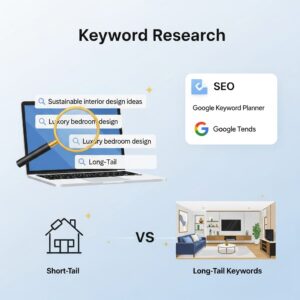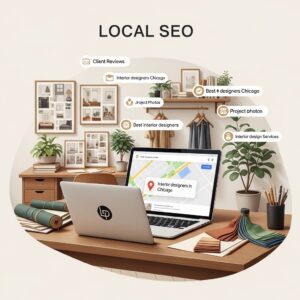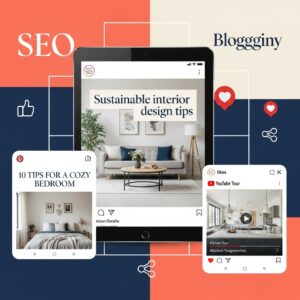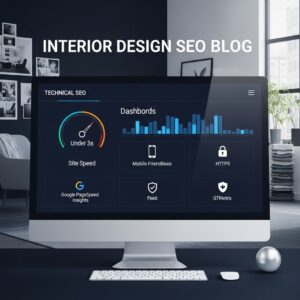Key Takeaways
Here are the key takeaways for mastering SEO for Interior Designers:
- Conduct keyword research with Google Trends to find long-tail keywords like “sustainable interior design ideas.”
- Optimize website UX with mobile-friendly design and clear navigation to reduce bounce rates.
- Ensure technical SEO with fast load times, HTTPS, and clean URLs for better crawlability.
- Optimize your Google Business Profile with local keywords and reviews to rank in nearby searches.
- Write blogs on topics like “10 Tips for a Cozy Bedroom” to attract traffic and showcase expertise.
- Use social media to share portfolio content and drive referral traffic to your site.
- Leverage digital PR for backlinks from design blogs or local media to boost authority.
- Track results with Google Analytics and Search Console to refine your SEO strategy.
The Ultimate Guide to SEO for Interior Designers Boost Your Online Visibility
Introduction
SEO for Interior Designers is a game-changer in today’s digital landscape, where standing out online can make or break your business. As an interior designer, you’re a master at crafting stunning spaces, but are potential clients finding you when they search Google? Effective SEO for Interior Design can drive high-quality clients to your website, boosting inquiries and bookings. According to HubSpot, 75% of users never scroll past the first page of Google search results, making it critical to rank high for terms like “luxury interior designers near me” or “modern kitchen design ideas.” Without SEO, even the most talented designers risk being invisible online. This comprehensive guide will walk you through the essentials of SEO for interior design businesses, covering keyword research, website UX optimization, technical SEO, on-page and off-page SEO, local SEO, blogging, social media, digital PR, result tracking, and advanced strategies. By leveraging tools like Google Trends, you can stay ahead of design trends and client needs. Whether you’re a solo designer or run a large firm, these actionable tips will help you attract more clients and grow your brand. Ready to transform your online presence? Let’s dive in!
Why SEO Matters for Interior Designers
SEO for Interior Designers is the key to standing out in a crowded online market. With over 67,000 interior designers in the U.S. alone, competition for client attention is fierce. Reddit’s r/interiordesign community often discusses struggles with online visibility, with many designers relying on word-of-mouth or social media alone. However, SEO for Interior Design drives qualified leads by connecting you with clients searching for specific services, like “modern kitchen design near me” instead of generic “interior design.” These targeted searches lead to higher conversion rates, as clients are already interested in your expertise.
The benefits of SEO go beyond traffic. Ranking high on Google builds credibility, as clients trust top results as industry leaders. It also increases website visits, bookings, and brand awareness without heavy reliance on paid ads. For example, optimizing for “sustainable interior design solutions” can attract eco-conscious clients, aligning with your niche. By investing in SEO, you’re building a pipeline of high-intent leads, ensuring your design business thrives in a competitive market.
Keyword Research: The Foundation of SEO
SEO for Interior Design begins with choosing the right keywords to attract your ideal clients. Keywords are the phrases potential clients type into Google, and selecting the right ones can make or break your visibility. Short-tail keywords, like “interior design,” are broad and competitive, while long-tail keywords, like “eco-friendly living room design ideas,” are specific and easier to rank for. According to Backlinko via HubSpot, 92% of all search queries are long-tail, making them critical for targeting niche audiences.
Use tools like Google Keyword Planner, Ahrefs, SEMrush, or Google Trends to identify high-value keywords. Google Trends is especially useful for spotting seasonal or regional design interests, such as “cozy bedroom design ideas” spiking in winter. A designer’s blog post on Houzz emphasized using client-friendly terms like “drapes” instead of “window treatments” to match search intent. Examples of effective keywords include “sustainable interior design solutions,” “luxury bedroom design ideas,” or “interior designers in [city].” Avoid keyword stuffing—overusing terms unnaturally can harm rankings. Instead, integrate keywords seamlessly into your website content to align with client intent and boost your SEO performance.

Website UX Optimization: Enhancing User Experience
SEO for Interior Designers isn’t just about keywords—it’s about creating a website that clients love to use. Website UX (user experience) optimization ensures your site is intuitive, visually appealing, and easy to navigate, which Google rewards with higher rankings. A seamless UX keeps visitors engaged, reducing bounce rates and increasing time spent on your site. For example, a clear menu with sections like “Portfolio,” “Services,” and “Contact” helps clients find what they need quickly.
Optimize your site for mobile, as 60% of searches occur on mobile devices (Google). Use responsive design to ensure your portfolio images and project pages look stunning on all screens. Simplify navigation by avoiding cluttered layouts, as discussed in r/web_design on Reddit, where designers share frustrations with complex sites losing clients. Include clear calls-to-action, like “Book a Consultation,” on every page. Fast load times, intuitive menus, and visually appealing designs inspired by sites like Tina Flint Studio can elevate your UX, making your site a client magnet and boosting your SEO for Interior Design.
Technical SEO: Building a Strong Foundation
SEO for Interior Designers requires a technically sound website to rank well on Google. Technical SEO focuses on behind-the-scenes elements like site speed, mobile-friendliness, and crawlability. A slow website frustrates users and hurts rankings—Google PageSpeed Insights recommends load times under 3 seconds. Compress images (under 3MB, as advised by Daniel James White) and use tools like GTmetrix to identify performance issues.
Ensure your site is mobile-responsive, as Google prioritizes mobile-first indexing. Fix broken links and set up proper redirects (e.g., 301 redirects for old pages) to avoid 404 errors, which can deter clients. Implement a clean URL structure, like “yourwebsite.com/sustainable-interior-design,” for clarity and SEO benefits. Secure your site with HTTPS, as 95% of Google’s traffic comes from secure sites (Search Engine Journal). Technical SEO, as discussed in r/SEO, ensures Google can crawl and index your site effectively, laying the foundation for higher rankings and better client reach.
On-Page SEO: Optimizing Your Website Content
SEO for Interior Designers involves optimizing every page on your website to rank higher and attract clients. On-page SEO includes elements like title tags, meta descriptions, headers (H1, H2), and image alt text, all tailored with keywords. For example, a portfolio page titled “Luxury Kitchen Design in Miami” signals your focus and location to Google. Since interior design sites are image-heavy, use descriptive alt text like “modern minimalist living room” and compress images for faster load times.
Incorporate keywords naturally into service pages, portfolio descriptions, and blog posts. A page about “sustainable interior design services” should include related terms like “eco-friendly home decor” in headers and text. Houzz recommends keyword-rich project descriptions to boost visibility. Use tools like Yoast SEO to optimize meta tags and ensure readability. By structuring your website with clear, keyword-optimized content and fast performance, you create a user-friendly experience that Google rewards, driving more traffic to your design business.
Off-Page SEO: Building Authority
SEO for Interior Design extends beyond your website with off-page strategies that build your site’s authority. Backlinks—links from other websites to yours—are a key factor. Guest posting on local architect blogs or design magazines, as shared in Reddit’s r/smallbusiness, can earn high-quality backlinks. Collaborating with suppliers, like furniture stores, for backlinks aligns with your industry and signals relevance to Google.
Client reviews are also critical. Findable Digital Marketing notes that reviews make up 15% of Google Maps’ ranking factors, so encourage satisfied clients to leave feedback on your Google Business Profile. Listing your business on directories like Yelp or Houzz further boosts authority. Digital PR, such as getting featured in local news or design blogs, enhances your credibility and earns valuable backlinks. These efforts show Google your site is trustworthy, improving rankings for terms like “luxury interior designers in [city]” and attracting high-quality clients.
Local SEO: Attracting Clients in Your Area

SEO for Interior Designers must include local SEO to attract nearby clients. Optimizing your Google Business Profile is essential—update hours, add high-quality project photos, and collect reviews. Use local keywords like “interior designers in Chicago” or “luxury home decorators in Miami” to target nearby clients. Google reports that 50% of local searches lead to a visit within 24 hours, highlighting local SEO’s power for driving inquiries.
Create location-specific landing pages, like “Our Dallas Interior Design Services,” as recommended by Yelp and Houzz. Post updates on your Google Business Profile, such as completed projects or seasonal promotions, to stay relevant. Encourage reviews, as positive feedback boosts visibility in Google Maps and local searches. By focusing on local SEO, you can dominate searches in your area and connect with clients ready to hire a nearby designer.
Blogging: A Powerful SEO Tool
SEO for Interior Design thrives on strategic blogging that attracts visitors and showcases expertise. Blogs target specific search intent, like a post on “small apartment decorating ideas” drawing clients seeking practical solutions. Tina Flint Studio saw a traffic spike after publishing a mood board blog post, as noted on their site. Blog topics like “10 Tips for a Cozy Bedroom” or “How to Choose Sustainable Materials” rank for long-tail keywords and keep visitors engaged. HubSpot reports that companies that blog get 55% more website visitors, proving its impact.
A designer’s post on Houzz highlighted how client success stories in blogs build trust and improve rankings. Use keywords naturally, like “modern office design ideas,” and include visuals like project photos. Promote blogs on social media or through email newsletters to drive traffic. By consistently publishing valuable content, you improve SEO and position yourself as an authority, encouraging clients to choose your services.
Social Media: Amplifying Your SEO Efforts
SEO for Interior Designers benefits greatly from a strategic social media presence. Platforms like Instagram and Pinterest are perfect for showcasing your portfolio, as they’re visual-heavy and popular among design enthusiasts. Share keyword-rich posts, like “sustainable interior design tips for small spaces,” to drive traffic to your website. According to Hootsuite, 54% of users research services on social media, making it a key channel for client discovery.
Engage with followers by responding to comments and sharing behind-the-scenes content, as suggested in r/socialmedia on Reddit. Cross-promote blog posts or portfolio pages with links to your site, boosting referral traffic and SEO signals. For example, a Pinterest pin linking to “luxury bedroom design ideas” can attract clicks and improve rankings. Use consistent branding and hashtags like #InteriorDesignInspiration to expand reach. By integrating social media with your SEO strategy, you amplify your online presence and attract more clients.
Digital PR: Elevating Your Brand
SEO for Interior Design gets a significant boost from digital PR, which builds your brand’s authority and visibility. Digital PR involves securing mentions in online publications, design blogs, or local news to earn high-quality backlinks. For example, a feature in a magazine like Dwell about your “eco-friendly home design” can drive traffic and signal credibility to Google. Reddit’s r/publicrelations highlights how designers gain exposure through local media partnerships, like sponsoring community events.
Pitch guest posts to design blogs or collaborate with influencers to showcase your work. Press releases about new projects or awards, as seen on Tina Flint Studio’s blog, can attract media attention. Ensure your website is linked in these features to maximize SEO benefits. Digital PR not only enhances your off-page SEO but also positions you as a thought leader, making clients more likely to trust and hire you.

Result Tracking: Measuring Your SEO Success
SEO for Interior Designers requires tracking results to ensure your efforts pay off. Monitoring performance helps you understand what’s working and where to improve. Use Google Analytics to track metrics like organic traffic, bounce rates, and conversions (e.g., contact form submissions). Google Search Console shows which keywords drive traffic, such as “luxury interior designers in [city],” and identifies pages needing optimization.
Set specific goals, like increasing blog traffic by 20% in six months, as recommended in r/SEO discussions. Tools like Ahrefs or SEMrush can track keyword rankings and backlink growth. For example, Tina Flint Studio noted a 30% traffic increase after optimizing for “modern office design ideas.” Regularly review your Google Business Profile insights to see local search performance and review trends. By analyzing data, you can refine your SEO for Interior Design strategy, ensuring consistent growth in traffic and client inquiries.
Advanced SEO Strategies
SEO for Interior Designers can go beyond the basics with advanced techniques to gain a competitive edge. Schema markup enhances portfolio pages by adding structured data, like project details, for rich snippets in search results. Voice search optimization is key, as 20% of mobile queries are voice-based (Search Engine Journal). Target conversational phrases like “best interior designer near me” to capture this audience. AI-driven tools like SurferSEO analyze content to align with top-ranking pages.
Reddit’s r/SEO community discusses trends like video SEO, where designers repurpose blog content into YouTube videos or Instagram Reels, such as a tour of a “sustainable kitchen design.” Using Google Trends, you can identify rising search terms, like “biophilic design ideas,” to create timely content. Repurpose content across platforms to maximize reach while reinforcing your brand. These advanced tactics help you stay ahead and attract tech-savvy clients searching for innovative design solutions.
Case Studies
SEO for Interior Design works best when you see it in action through real-world examples. A fictional Austin-based designer increased leads by 40% by optimizing their Google Business Profile and targeting “Austin interior design services”. They added reviews, project photos, and a location-specific landing page, boosting local rankings. Another commercial designer saw a 60% traffic increase by blogging about “modern office design ideas” and earning backlinks from design magazines, as inspired by Tina Flint Studio.
Houzz highlights a designer who ranked higher by using keyword-rich project galleries, like “luxury bedroom design in Seattle.” They also leveraged social media to share blog posts, driving referral traffic. These case studies show how combining local SEO, blogging, social media, and digital PR can transform your online presence, turning clicks into booked projects and building a sustainable client pipeline.
FAQs
SEO for Interior Designers can be confusing, so here are answers to common questions to clarify the process:
- What is SEO for Interior Designers, and why is it important?
SEO helps your website rank higher on Google, connecting you with clients searching for design services. It’s critical because 75% of users stick to the first page of search results (HubSpot). - How do I choose the best keywords for my interior design website?
Use tools like Google Keyword Planner or Google Trends to find long-tail keywords like “sustainable interior design ideas.” Focus on terms specific to your niche and location. - How long does it take to see SEO results?
SEO typically takes 3–6 months to show significant results, depending on competition and consistency. Regular content updates and result tracking can accelerate progress. - Should I hire an SEO agency or do it myself?
DIY SEO is possible with tools like SEMrush, but agencies offer expertise for competitive markets. Evaluate your budget and goals. - How does local SEO help interior designers?
Local SEO targets nearby clients with keywords like “interior designers in Miami” and optimizes your Google Business Profile. It drives 50% of local searches to visits within 24 hours (Google). - What are the best tools for SEO for Interior Design?
Google Analytics, Search Console, Ahrefs, and Google Trends are ideal for tracking performance, keyword research, and trend analysis. Yoast SEO helps optimize content. - How can social media and digital PR improve SEO?
Social media drives traffic and engagement, while digital PR earns backlinks from publications. Both boost your site’s authority and rankings.
Conclusion
SEO for Interior Designers is your ticket to reaching more clients online and growing your business. Keyword research and Google Trends help you target terms like “luxury bedroom design ideas” that attract high-intent clients. Website UX optimization and technical SEO ensure your site is user-friendly and crawlable, while on-page and off-page SEO, including digital PR, build authority. Local SEO connects you with nearby clients, and blogging establishes expertise. Social media amplifies your reach, and result tracking keeps your strategy on track. Start with one step—set up your Google Business Profile or post a blog on “sustainable interior design solutions.” Ready to boost your SEO? Contact us for a free website audit and take your online presence to the next level!

